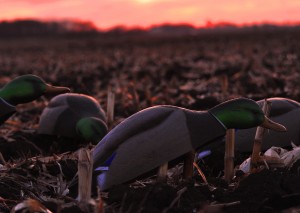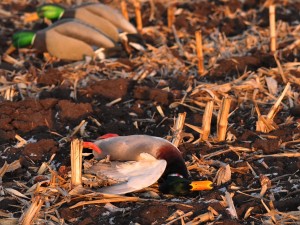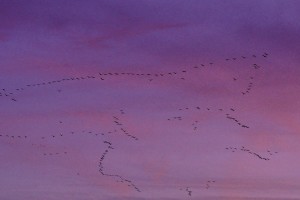Photography courtesy of Lowell Washburn, all rights reserved.
Today was the last hurrah for Iowa’s [north
zone] 2013 duck season. It was about as cold as a duck hunt can
get. Skies were clear and, depending on which station you li stened to,
sunrise temperatures ranged anywhere from 6 to 10 degrees with WNW winds
gusting from 35 to 40 mph. At Clear Lake, it was a genuine Blue Finger
morning and wind chill calculations were definitely in order. According
to the ‘old’ Weather Service model, wind chill indexes were running in the
vicinity of 40 below. By using the ‘new’ index, wind chills registered a
more balmy 14 or 15 below zero. By either standard, the weather could
only be described as ‘somewhat chilly’.

With the countryside now frozen solid, my only viable duck hunting option was
the tract of corn stubble I currently occupied. My spread consisted of
mallard field decoys and a pair of Lucky Ducks. Other than some
protruding corn stalks, there was no cover whatsoever; and I was pretty sure we
were going by the ‘old’ Weather Service model for wind chill. Although the
morning brought a never ending procession of southbound geese — including a
group of 25 or 30 snows — no ducks passed overhead. Laying on my back on
the ground began to exact its toll. By 8:30, my gloves felt as if they
were made from mosquito netting and the exposed skin on my face was beginning
to hurt. I remembered that I had a couple of those little, chemical
activated hand warmers back in the truck and decided to give them a try.
While at the truck, I gave my friend Dave Thomas a call to see what he had
going for the day. While talking to him, a nice flock of mallards
suddenly dropped in to work the field, but left after three or four low
passes. Never fails! Those were the only ducks that worked all
morning. Wish I’d have been there to greet them.
About 11 o’clock I decided to take a lunch break. After consuming some
extra spicy Asian cuisine, I felt all warmed up again and ready to jump back
into the decoys. Flocks of geese were still passing — more or less
nonstop — from the north. By around 2 o’clock, I began to see a few
ducks. A single drake mallard came spiraling out of the stratosphere and,
on the fourth pass, came in to a range of around 20 yards. I fired — and
missed — with both barrels. A dull pain on my right bicep reminded me
that “improper mounting of the shotgun” is a major cause for missed
shots on game. Another group of 5 ducks gave me a serious look but never
came closer than 25 or 30 yards. I also saw several large flocks of
mallards way, way up in the sky and I figured the next place they touched down
would probably be somewhere in Missouri. By 3:30 or so, the flocks were
becoming more scarce and nearly all of those were Canadas. The sun had
began to lower and the late afternoon color was spectacular. I fantasized
over how beautiful close range birds would look under the current light
conditions. That’s when I spotted them — a flock of 30 or more mallards
headed my way. Although the the birds were still fairly high and a good
ways out, there was something about them that made you “just know”
that they were going to work. Sure enough, when the birds were
still a hundred or so yards out they suddenly locked up and began their
decent. There was no wariness. There was no hesitation. Without
so much as a single circle, the entire flock piled in on the first
approach. The birds loomed closer and closer until the leaders were on
the deck and braking for a landing. And, if I hadn’t sat up to shoot, I’m
confident the whole works would have promptly touched down at the edge of the
decoys. The intensity of color — especially on the drakes — was
everything I had imagined. The scene was, in a word, unforgettable.
I sat up; the birds flared back; I picked a drake and fired. The duck
folded and I quickly moved to another plump drake. I fired again.
Clean miss. My hands felt clumsy and I could barely feel the trigger on
the shotgun. I finally decided that I had probably killed the duck by
accident. Nevertheless, the drake was a fine specimen. The duck was
hog fat with bright legs, full curls, chrome yellow bill, emerald green head,
and perfect white collar. All in all, the greenhead was a memorable
closure to what has been an incredible North Iowa duck season. Can’t
believe how fast the season went.



 Tom Cope
Tom Cope Sue Wilkinson
Sue Wilkinson Susan Judkins Josten
Susan Judkins Josten Rudi Roeslein
Rudi Roeslein Elyssa McFarland
Elyssa McFarland Mark Langgin
Mark Langgin Adam Janke
Adam Janke Joe Henry
Joe Henry Kristin Ashenbrenner
Kristin Ashenbrenner Joe Wilkinson
Joe Wilkinson Dr. Tammy Mildenstein
Dr. Tammy Mildenstein Sean McMahon
Sean McMahon